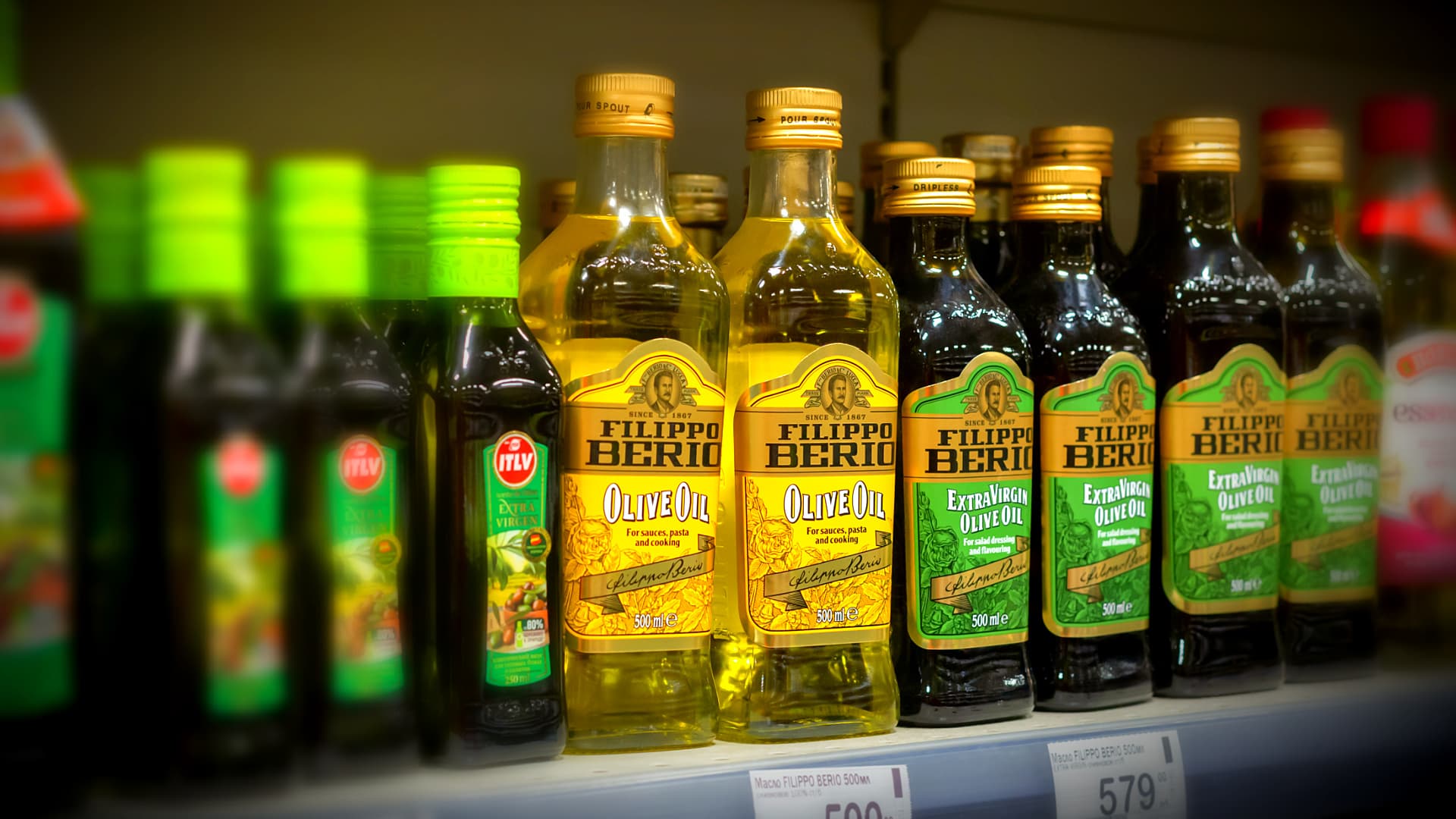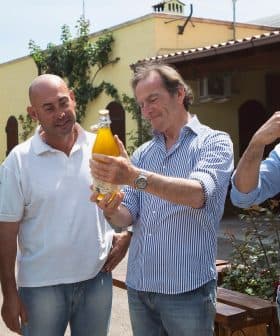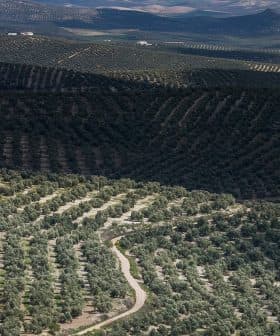Filippo Berio Execs See Equilibrium Returning to The Global Olive Oil Market

European extra virgin olive oil prices at origin have reached their lowest levels since October 2022, with Spain expected to have a positive fruit set this spring, potentially leading to further price decreases. While Spain, Italy, Portugal, and Greece are expected to have significant olive oil production increases, Italy faces production declines due to systemic issues, with the government working on initiatives to revitalize the sector.
According to market data from Granaria Milano, European extra virgin olive oil prices at origin have fallen to their lowest levels since October 2022.
The Milan-based trade association, which publishes weekly agricultural commodity prices, indicated that the average price for European extra virgin olive oil (excluding Italy) is €4,750 per metric ton.
Walter Zanre, the managing director of Filippo Berio UK, told Olive Oil Times that prices at origin across Europe, except for Italy, may keep falling if there is a positive fruit set in Spain later this spring.
If there’s a good flowering, then I expect prices to weaken quite considerably. If there’s a poor flowering, then we’re back into the good year, bad year cycle, which could force pricing up.
“At the beginning of 2022, prices were lower than they are today, which is why I think there’s room for price to come down if there is the prospect of another good crop,” he said.
Filippo Berio’s latest data show that Spain is expected to produce between 1.43 and 1.45 million tons of olive oil in the 2024/25 crop year, the largest harvest since 2021/22 and the second highest since 2018/19.
”Tunisia and Turkey are also forecasting big productions, and that is the result of high prices, which have attracted money to the sector,” Zanre said. “Some of the olives that would’ve been destined to table olives have been diverted into the olive oil crushing business because there’s a better return short-term.”
See Also:Olive Oil Demand Expected to Grow Alongside SupplyFilippo Berio data further forecasted that Greek olive oil production would reach 280,000 tons, Portugal would harvest 150,000 tons, Morocco’s yield would rebound to 120,000 tons, and Syria would produce 140,000 tons.
Despite the rebound, Zanre said most of the olive oil produced in Turkey and Syria, along with a significant portion of Tunisian and Moroccan production, is destined for Middle Eastern countries. Therefore, this olive oil would have a less substantial impact on European and North American markets compared to Spain, Italy, Portugal, and Greece.
“Global production is coming in at around 3.3 million tons, which is the highest for quite some time and puts everything back into equilibrium,” he added.
The latest data from Spain manifest the return of equilibrium to the olive oil market, where monthly sales have returned to their normal levels before the two historically poor harvests in 2022/23 and 2023/24.
Olive oil sales reached 110,000 tons in February, “which is where Spain normally is,” Zanre said. “ Last year, Spain had been 60,000 to 70,000 tons a month restricted purely by the availability of oil.”
The next three months will be decisive in determining the future direction of olive oil prices. Whether cooperatives and bottlers sit on replenished stock to last until 2026 or try to move product more quickly will depend on the fruit set in May.
“ At the moment, the co-ops are sitting on just over 880,000 tons, and bottlers’ stocks are at 200,000 tons, the highest since July 2023,” Zanre said. “Bottlers had reduced their stock holdings since olive oil had become so expensive.”

Walter Zanre expects prices at origin to continue to decline if Spain experiences a positivie fruit set. (Photo: Filippo Berio)
“By the latter part of 2024 into January, everybody was trying to carry no stock because they were expecting the price to come down,” he added. “But bottlers are now back to normal stock levels, which means that the availability problems retailers have seen probably from October to January are now going away.”
While prices at origin have stabilized, Marco De Feo, the vice-president of marketing at Filippo Berio USA, expects some lag time before consumers find lower olive oil prices on the supermarket shelves.
“Even though we’ve seen a drop in raw material costs, we have not seen the full effect of shelf price reduction,” he said. “Supermarkets still have stock at the old price, and it will take time to deplete the current stock — maybe two or three months — and then we might start seeing a price reduction on the shelf.”

Marco De Feo said there would be a lag before consumers see lower prices in the supermarket. (Photo: Filippo Berio)
In the meantime, Zanre said everyone in the sector is waiting to see how the flowering evolves in Spain.
Another wet winter means reservoirs have refilled across Andalusia, which is responsible for most Spanish olive oil production. Temperatures in April and May will dictate the 2025/26 crop year’s outcome.
The significant production declines in 2022/23 and 2023/24 were mainly due to extreme heat in May damaging the olive trees as they flowered, which prevented any fruit from setting.
“If there’s a good flowering, then I expect prices to weaken quite considerably,” Zanre said. “If there’s a poor flowering, then we’re back into the good year, bad year cycle, which could force pricing up.”
“But if there’s good flowering, the Spanish crushers will not want to be holding stocks carrying them into next year,” he added.
Lowering prices at origin have made some Spanish producers wary of returning to the situation they found themselves in at the beginning of the decade when prices at origin dropped below the cost of production.
Zanre warned that a bumper harvest in Spain and strong harvests in Italy and elsewhere in the Mediterranean basin could cause prices at origin to fall to similarly low levels.
”Spain has production costs of around €2.50 per liter,” he said. “ Anything that gets down towards €2.50 or below becomes a real problem for the industry.”
“Unfortunately, we have a marketplace with no futures,” Zanre added. “You buy and you take delivery which makes it highly speculative.”
However, the situation is distinct in Italy, where Filippo Berio anticipates production to decline to 200,000 tons in 2024/25. Granaria Milano data indicate that extra virgin olive oil prices in Italy originate at €9,600 per ton.
“I can’t see any reason other than a really good flowering for the Italian price to come down,” Zanre said.
He attributed this year’s production decline in Italy primarily to the olive tree’s natural alternate bearing cycle, with many producers entering an ‘off-year.’
On and off years
Olive trees have a natural cycle of alternating high and low production years, known as “on-years” and “off-years,” respectively. During an on-year, the olive trees bear a greater quantity of fruit, resulting in increased olive oil production. Conversely, an “off-year” is characterized by a reduced yield of olives due to the stress from the previous “on year.” Olive oil producers often monitor these cycles to anticipate and plan for variations in production.
However, Zanre added that broader systemic issues in Italy have steadily declined olive oil yields over the past decade.
“There’s declining production in Italy for two reasons,” he said. “One is the Xylella fastidiosa problem in Puglia where they’ve lost six million trees. The other thing is that Italy hasn’t been investing in olive agriculture, unlike Spain, so you’ve got a declining pool of production.”
Zanre pointed to Portugal and Spain, where large producers and private equity have made significant investments to plant new super-high-density groves in the southern regions of Alentejo and Andalusia and develop new milling technology to maximize yield and quality.
“There is a desire in Italy to change that,” he said. “The problem is that it takes five to seven years before an olive tree is producing commercially, and the people with the money don’t want to wait five to seven years.”
As a result, he believes the Italian government will need to spearhead any initiative to revitalize Italian olive oil production.
Indeed, the government is currently working to implement a National Olive Plan to plant thousands of new groves, fund upgrades to existing mills, and create an interprofessional association to promote the sector.
In the meantime, Zanre anticipates that olive oil production could continue to rise in Spain. “There is the capacity to exceed two million tons,” he concluded.










